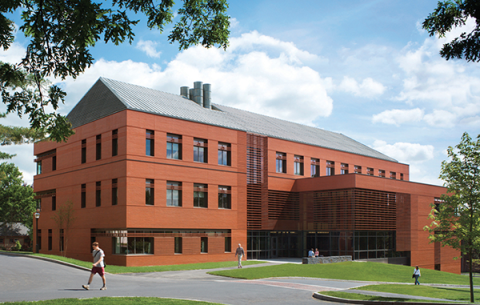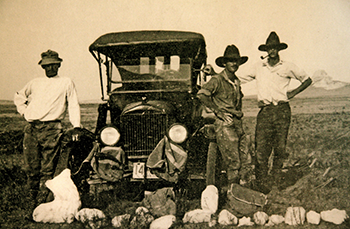Our Mission

The museum is located on the Amherst College campus in the Beneski Earth Sciences building, often referred to as simply “Beneski,” where students and faculty move seamlessly between state-of-the-art geology teaching labs and the museum.
The museum is dedicated to:
- Preserving and interpreting the physical evidence of the geological history of the Earth, the evolutionary history of its inhabitants, and the processes that have shaped both through time
- Providing direct experience with the materials and former inhabitants of the Earth
- Challenging visitors to consider problems of scientific interpretation
- Stimulating the scientific curiosity and observational acuity of students and scholars, fostering in them a spirit of inquiry, stewardship and wonder toward the Earth

History of the Collections
The extensive and diverse collections at the Beneski Museum are the result of the work of faculty, students and alumni over the course of the College’s history, derived from expeditions, donations and exchanges.
The physical and biological sciences have been a vital part of the Amherst College curriculum from the time of its founding 1821. Providing natural history specimens for direct hands-on study has been an integral component of teaching, learning and research in the sciences ever since.
Five Amherst professors in particular helped shape the museum’s collection into what it is today:
Edward Hitchcock
Edward Hitchcock joined the College faculty in 1825. He had wide-ranging interests and the dynamic energy to execute numerous scientific investigations and ensuing publications. Hitchcock encouraged alumni to send back scientific specimens from all over the world, no doubt spurred by his own excursions collecting geologic and fossil specimens from local sites in the Connecticut River Valley. One of his collections, the Hitchcock Ichnology Collection (ichnology is the study of tracks and traces), continues to be among the world's largest and most studied collections of fossil dinosaur tracks.
Hitchcock was a preeminent early geologist. He collaborated with, wrote to and met with the most important earth scientists of the day in North America and Europe including Benjamin Silliman, Richard Owen, Adam Sedgwick, Charles Lyell, Louis Agassiz and Charles Darwin. Hitchcock was a founder of the Association of American Geologists, which gave rise to today’s American Association for the Advancement of Science. (More about Hitchcock)
Charles Upham Shepard and Benjamin K. Emerson
Charles Upham Shepard, Class of 1824, and Benjamin K. Emerson, Class of 1865, joined the faculty during the 19th century and strengthened the role of science at Amherst College. Shepard was responsible for the original mineral collection, considered one of the finest in the country at the time. Emerson expanded the mineral and invertebrate paleontology collections as well as Hitchcock’s collection of the rocks of Massachusetts.
Frederic Brewster Loomis and Albert E. Wood
In the early 20th century, Biology Professors Frederic Brewster Loomis, Class of 1896, and Albert E. Wood added many important vertebrate fossils to the museum collections. Loomis ventured on 18 summer expeditions with Amherst students to excavate Mesozoic and Cenozoic vertebrate fossils in the United States and South America. His many connections throughout the vertebrate paleontology community allowed him to bring significant specimens to the College through trade or gift. His contributions account for the majority of the vertebrate megafauna (dinosaurs to Ice Age mammals) on display in the museum today. (More about Loomis)
Wood was a charter member of the Society of Vertebrate Paleontology, the preeminent professional society in that field, which now gives an annual award in his name for student research in museum natural history collections. Wood’s field of study was rodent evolution; as a consequence, the museum’s holdings in these diminutive fossils are extensive.